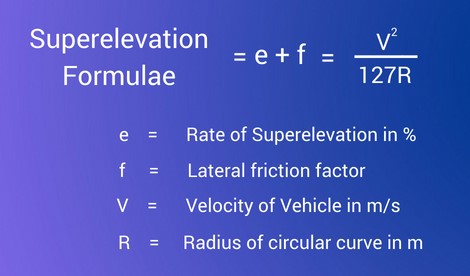Superelevation is the transverse slope provided to prevent the effect of centrifugal force and decrease the tendency of the vehicle to overturn and to skid laterally outwards by raising the pavement outer edge with respect to the inner edge. Superelevation is generally indicated by “e”.

Table of Contents
Advantages of Superelevation
- Superelevation increases the speed of vehicles on the highway.
- It reduces the stresses on-road foundation.
- It provides stability to vehicles.
Derivation of Superelevation
We have to find the angle of elevation or superelevation

tanθ = E⁄B ( Refer above figure )
As we know that, there are three forces acts on any vehicle
Weight of the vehicle = W kg (↓) ;
Centripetal force = P (→);
Frictional forces = F1 & F2 (← );

By solving,
e + f = V2/ 127R
Where,
e= Rate of super elevation
f= Lateral friction factor
V= Velocity of vehicle
R= Radius of circular curve

Thus, P.Cosθ = W.Sinθ+F1+F2
where F = fR
P.Cosθ = WSinθ + fR1 + fR2
= W.Sinθ + f(R1 + R2)
= W.Sinθ + f(PSinθ+WCosθ)
P.Cosθ-f.PSinθ = W.Sinθ+f.WCosθ
Divide by “W.Cosθ”;
(P.Cosθ-f.PSinθ)⁄W.Cosθ = (W.Sinθ+f.WCosθ)⁄W.Cosθ
P⁄W -(f.P⁄W)tanθ = tanθ + f
P⁄W (1-f.tanθ) = tanθ+f
P⁄W = (tanθ+f)⁄1-f.tanθ
P⁄W = e + f
But, P⁄W = V2/ gR
Hence, e + f = V2/ gR
Where,
e = rate of Super elevation in percent
V = velocity of vehicle in m/s
f = lateral friction factor = 0.15
g = acceleration due to gravity = 9.81 m/s2
R = radius of circular curve in meters.
If velocity is in KMPH then e + f = V2/ 127R
Super Elevation formula:-

This formula is utilized only to find out one of the missing values either e or f or V or R for design purposes consider the below procedure.
Design procedure of Superelevation:-
The design procedure includes the following steps
Step – 1:-
Find out the Superelevation (e) necessary for 75% design speed [0.75V] and assume no lateral friction is developed.
As per practical conditions, it is suggested that superelevation should be provided to fully counteract the centrifugal force because 75% of the Design Speed (V) by neglecting lateral friction (f=0) developed.
Super Elevation formula = e + f = [V2]/127R
Consider lateral friction f = 0;
75% of design speed which means V= 0.75V
As per formula,
e + f = [V2]/127R
e + 0 = [0.75V]2/127R
e = V2 / 225R
Note: e value should not be more than 0.07
If the calculated value (ecal) is less than (emax) then consider the value of (ecal) if not proceed to the next step,
if (ecal<emax) then e = ecal
If the calculated value (ecal) is greater than (emax) then consider the value of (emax)
if (ecal<emax) then e = emax
Step – 2:-
Lets assume e = emax = 0.07 and proceed to next step.
Step-3: Calculate the value of friction for ‘e’ Value
Super Elevation formula = e + f = [V2]/127R
= 0.07 +f = [V2]/127R
f = [V2]/127R – 0.07
Step – 3:-
From the above step, we found the value of e. Now let’s find the value of the lateral friction (f) for the known value of emax Value
Super Elevation = emax + f = [V2]/127R
= 0.07 + f = [V2]/127R
fcal = [V2/127R] – 0.07
If fcal < fmax (0.15)
Then fcal = f ;
If fcal > fmax (0.15)
Then e = 0.07 is safe.
But if fcal > 0.15
Then fcal =fmax (0.15)
Step – 4:-
Lets calculate the value of Restricted Speed (Va)
Therefore V = Va
Super Elevation = e + f = [V2]/127R
= 0.07 + 0.15 = (Va)2/127R
V = [127R(0.22)]1/2
If Va > V then e = 0.07, f = 0.15
If Va < V still e = 0.07 and f = 0.15 but the speed restriction board is provided along with consists the value of Va.
